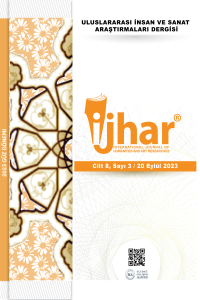Abstract
Bu araştırmanın konusu, Amerika Birleşik Devletleri tarihinin en büyük belgesel fotoğraf çalışması olarak tanımlanan ve belgesel fotoğrafta bir zirve noktası olarak nitelenen Çiftlik Güvenlik İdaresi (Farm Security Administration) tarafından gerçekleştirilen fotoğrafik belgeleme çalışmasıdır. 1935 ile 1943 yılları arasında gerçekleştirilen ve kısaca FSA olarak adlandırılan bu kolektif belgeleme çalışması, Büyük Bunalım’dan, kuraklık ve kum fırtınalarından en fazla etkilen kesim olan tarım işçilerinin içinde bulunduğu zorlu koşullara fotoğrafik görünürlük kazandırmak ve sorunlar hakkında kamuoyu oluşturarak toplumsal değişim sağlamak amacındaydı. Dolayısıyla, Çiftlik Güvenlik İdaresi çatısı altında gerçekleştirilen belgesel fotoğraf projesi, aynı zamanda ideolojik açılımları ve sonuçları olan bir çalışmaydı. Bu nedenle, bu araştırmada, Çiftlik Güvenlik İdaresi fotoğrafçıları tarafından üretilen fotoğrafik imgelerin politik değerini Frankfurt Okulu’nun geliştirmiş olduğu kültür endüstrisi kavramı ve eleştirel teori ışığında anlamak ve keşfetmek amacında olunmuş ve bu amacı gerçekleştirebilmek için imge çözümleme yöntemlerinden biri olan göstergebilimsel yöntem kullanılmıştır.
Kültür ürünlerinin statükoyu üreten ve yeniden üreten yönlerini ifşa ederek, ideolojik ve söylemsel alanda oynadıkları rolü sorgulayan Frankfurt Okulu üyeleri, ekonomik düzeyden çok kültürel düzeyde neler olup bittiğini sorunsallaştırır. Frankfurt Okulu’nun bir üyesi olan Theodor Adorno ve Max Horkheimer, geliştirmiş oldukları kültür endüstrisi kavramıyla, geç kapitalizm koşullarında kültürün endüstrileştiğine ve bir kitle aldatmacasına dönüştüğüne göndermede bulunur. Endüstriyel kültür, doğal ve kendiliğinden bir kültür değil, kitleler için yukarıdan ve bilinçli bir biçimde programlanmış yapay bir kültürdür. Frankfurt Okulu üyelerinin toplum eleştirileri, aynı zamanda eleştirel teori olarak nitelenir ve eleştirel teori, geleneksel teori yani pozitivizm karşıtlığı üzerinden kendini tanımlar. Bilgiyi algıya eşitleyen ve böylece statükonun tarihselliğinin üstünü örterek onu değişmezmiş gibi göstermeye çalışan geleneksel teori, kapitalizmin bilim ve bilgi anlayışı olması nedeniyle eleştirel teorinin temel kritik uğraklarından biridir. Bu araştırmada, Çiftlik Güvenlik İdaresi tarafından gerçekleştirilen fotoğrafik belgeleme çalışmasının, doğalcı ve olgucu bir yaklaşım ortaya koyması nedeniyle, geleneksel teorinin epistemolojik sınırlarına karşılık geldiği sonucuna varılmıştır. Bu fotoğrafik araştırma, tarım işçileri hakkındaki gerçeği algılanabilir ya da gözlemlenebilir yönleriyle ele alması nedeniyle, izleyicide acıma ve merhamet gibi duygulanımlara yol açmış ve bu durum izleyicideki gerçek bir eleştirel tavrın önüne geçmiştir. Çiftlik Güvenlik İdaresi çalışması, toplumsal çelişkilerin tarihselliğini gizleyerek statükonun değişmezliğini vurgulamış ve toplumsal kontrolle sonuçlanmıştır. Bu nedenle, araştırmanın bir diğer bulgusu, Çiftlik Güvenlik İdaresi çalışması özelinde fotoğrafik medyumun bir kültür endüstrisi olarak işlev görmüş olmasıdır.
Keywords
Çiftlik Güvenlik İdaresi Fotoğraf Belgesel Fotoğraf Frankfurt Okulu Kültür Endüstrisi Eleştirel Teori Geleneksel Teori.
References
- Adorno T W, Horkheimer M (2002). Dialectic of Enlightenment. (Çev.: Edmunt Jephcott). Stanford: Stanford University Press.
- Adorno T W, Horkheimer M (2010). Sosyolojik Açılımlar. (Çev.: Sezai Durgun ve Adnan Gümüş). Ankara: BilgeSu Yayıncılık.
- Adorno T W, Horkheimer M (2014). Aydınlanmanın Diyalektiği. (Çev.: Nihat Ülner ve Elif Öztarhan Karadoğan). İstanbul: Kabalcı Yayınevi.
- Adorno, T W (1977). “The Logic of the Social Sciences”. David Frisby (Ed.), The Positivist Dispute in Germen Sociology içinde (ss. 105-122). (Çev.: Glyn Adey ve David Frisby). London: Heineman Educational Books.
- Adorno, T W (2014). “Kültür Endüstrisine Genel Bir Bakış”. Ali Artun (Der.), Kültür Endüstrisi: Kültür Yönetimi içinde (ss. 109-119). (Çev.: Mustafa Tüzel). İstanbul: İletişim Yayınları.
- Bottomore, T (1991). A Dictionary Of Marxist Thought. Oxford: Blackwell Publishers.
- Cevizci, A (2022). Felsefe Tarihi: Thales’ten Baudrillard’a. İstanbul: Say Yayınları.
- Comte, A (2019). Pozitif Felsefe Dersleri ve Pozitif Anlayış Üzerine Konuşma. (Çev.: Erkan Ataçay). Ankara: BilgeSu Yayıncılık.
- Goldberg, V (1991). The Power of Photography: How Photographs Changed Our Lives. New York: Abbeville Press.
- Hine, L W (1980). “Social Photography”. Alan Trachtenberg (Ed.), Classic Essays on Photography içinde (ss. 109-113), New Haven: Leete's Island Books.
- Hine, L W (1986). “Fotoğrafın Toplumsal Gelişmeye Katkısı”. (Çev.: Mehmet Ünal). Fotoğraf, 36: 8-12.
- Horkheimer, M (2005). Geleneksel ve Eleştirel Kuram. (Çev.: Mustafa Tüzel). İstanbul: Yapı Kredi Yayınları. Lewis, E (2020). …isms: Understanding Photography. New York: Routledge.
- Marcuse, H (1955). Reason and Revolution: Hegel and the Rise of Social Theory. London: Routledge & Kegan Paul. Nevins A, Commager H S (2014). ABD Tarihi. (Çev.: Halil İnalcık). Ankara: Doğu Batı Yayınları.
- Newhall, B (1949). The History of Photography. New York: The Museum of Modern Art.
- Partridge, R (2010). “Dorothea Lange in the Field”. Ken Light (Ed.), Witness in Our Time içinde (ss. 203-209). Washington: Smithsonian Books.
- Stange, M (1989). Symbols of Ideal Life: Social Documentary Photography in America 1890-1950. Cambridge: Cambridge University Press.
- Storer, C (2015). Weimar Cumhuriyeti'nin Kısa Tarihi. (Çev.: Sedef Özge). İstanbul: İletişim Yayınları.
- Stryker, R (1988). “The FSA Collection of Photographs”. Vicki Goldbelg (Ed.), Photography in Print içinde (ss. 349-354). Albuquerque: University of New Mexico Press.
- Taylor, P (1988). “Migrant Mother: 1936”. Vicki Goldbelg (Ed.), Photography in Print içinde (ss. 355-357). Albuquerque: University of New Mexico Press.
- Thompson, J L (2012). The Story of a Photograph: Walker Evans, Ellie Mae Burroughs and the Great Depression. Kindle Edition. United States: Now and Then Reader.
Rethinking Farm Security Administration in the Light of Critical Theory and the Notion of Culture Industry
Abstract
The subject of this research is the photographic documentation work carried out by the Farm Security Administration (FSA), which is defined as the largest documentary photography work in the history of the United States and is characterized as a pinnacle in documentary photography. Conducted between 1935 and 1943, this collective documentation work, referred to as the FSA for short, aimed to bring photographic visibility to the harsh conditions of agricultural workers, who were most affected by the Great Depression, drought and sandstorms, and to bring about social change by creating public opinion about the problems. Therefore, the documentary photography project carried out under the umbrella of the Farm Security Administration was also a project with ideological implications and consequences. For this reason, this research aims to understand and explore the political value of the photographic images produced by FSA photographers in the light of the concept of culture industry and critical theory developed by the Frankfurt School, and in order to achieve this goal, the semiotic method, one of the methods of image analysis, was used.
Exposing the aspects of cultural products that produce and reproduce the status quo and questioning the role they play in the ideological and discursive sphere, members of the Frankfurt School problematized what was going on at the cultural level rather than the economic level. According to these thinkers, industrial culture is not a natural and spontaneous culture, but an artificial culture programmed from above and consciously for the masses. The Frankfurt School members' criticism of society is also characterized as critical theory, and critical theory defines itself through the opposition to traditional theory, that is, positivism. Traditional theory, which equates knowledge with perception and thus tries to cover up the historicity of the status quo and present it as unchanging, is one of the main critical junctures of critical theory as it is capitalism's understanding of science and knowledge. In this research, it is concluded that the photographic documentation carried out by the FSA corresponds to the epistemological limits of traditional theory, as it presents a naturalistic and factualist approach. This photographic research, by addressing the truth about agricultural workers in its perceivable or observable aspects, elicited emotions such as pity and compassion in the viewer, which prevented a genuine critical attitude on the part of the viewer. By concealing the historicity of social contradictions, the FSA work emphasized the immutability of the status quo and resulted in social control. Therefore, another finding of the research is that the photographic medium, in the specific case of the FSA work, functioned as a culture industry.
Keywords
Farm Security Administration Photography Documentary Photography Frankfurt School Critical Theory Traditional Theory Culture Industry.
References
- Adorno T W, Horkheimer M (2002). Dialectic of Enlightenment. (Çev.: Edmunt Jephcott). Stanford: Stanford University Press.
- Adorno T W, Horkheimer M (2010). Sosyolojik Açılımlar. (Çev.: Sezai Durgun ve Adnan Gümüş). Ankara: BilgeSu Yayıncılık.
- Adorno T W, Horkheimer M (2014). Aydınlanmanın Diyalektiği. (Çev.: Nihat Ülner ve Elif Öztarhan Karadoğan). İstanbul: Kabalcı Yayınevi.
- Adorno, T W (1977). “The Logic of the Social Sciences”. David Frisby (Ed.), The Positivist Dispute in Germen Sociology içinde (ss. 105-122). (Çev.: Glyn Adey ve David Frisby). London: Heineman Educational Books.
- Adorno, T W (2014). “Kültür Endüstrisine Genel Bir Bakış”. Ali Artun (Der.), Kültür Endüstrisi: Kültür Yönetimi içinde (ss. 109-119). (Çev.: Mustafa Tüzel). İstanbul: İletişim Yayınları.
- Bottomore, T (1991). A Dictionary Of Marxist Thought. Oxford: Blackwell Publishers.
- Cevizci, A (2022). Felsefe Tarihi: Thales’ten Baudrillard’a. İstanbul: Say Yayınları.
- Comte, A (2019). Pozitif Felsefe Dersleri ve Pozitif Anlayış Üzerine Konuşma. (Çev.: Erkan Ataçay). Ankara: BilgeSu Yayıncılık.
- Goldberg, V (1991). The Power of Photography: How Photographs Changed Our Lives. New York: Abbeville Press.
- Hine, L W (1980). “Social Photography”. Alan Trachtenberg (Ed.), Classic Essays on Photography içinde (ss. 109-113), New Haven: Leete's Island Books.
- Hine, L W (1986). “Fotoğrafın Toplumsal Gelişmeye Katkısı”. (Çev.: Mehmet Ünal). Fotoğraf, 36: 8-12.
- Horkheimer, M (2005). Geleneksel ve Eleştirel Kuram. (Çev.: Mustafa Tüzel). İstanbul: Yapı Kredi Yayınları. Lewis, E (2020). …isms: Understanding Photography. New York: Routledge.
- Marcuse, H (1955). Reason and Revolution: Hegel and the Rise of Social Theory. London: Routledge & Kegan Paul. Nevins A, Commager H S (2014). ABD Tarihi. (Çev.: Halil İnalcık). Ankara: Doğu Batı Yayınları.
- Newhall, B (1949). The History of Photography. New York: The Museum of Modern Art.
- Partridge, R (2010). “Dorothea Lange in the Field”. Ken Light (Ed.), Witness in Our Time içinde (ss. 203-209). Washington: Smithsonian Books.
- Stange, M (1989). Symbols of Ideal Life: Social Documentary Photography in America 1890-1950. Cambridge: Cambridge University Press.
- Storer, C (2015). Weimar Cumhuriyeti'nin Kısa Tarihi. (Çev.: Sedef Özge). İstanbul: İletişim Yayınları.
- Stryker, R (1988). “The FSA Collection of Photographs”. Vicki Goldbelg (Ed.), Photography in Print içinde (ss. 349-354). Albuquerque: University of New Mexico Press.
- Taylor, P (1988). “Migrant Mother: 1936”. Vicki Goldbelg (Ed.), Photography in Print içinde (ss. 355-357). Albuquerque: University of New Mexico Press.
- Thompson, J L (2012). The Story of a Photograph: Walker Evans, Ellie Mae Burroughs and the Great Depression. Kindle Edition. United States: Now and Then Reader.
Details
| Primary Language | Turkish |
|---|---|
| Subjects | Photography, Video and Lens-Based Practice |
| Journal Section | Research Articles |
| Authors | |
| Early Pub Date | September 17, 2023 |
| Publication Date | September 20, 2023 |
| Submission Date | August 15, 2023 |
| Acceptance Date | September 15, 2023 |
| Published in Issue | Year 2023 Volume: 8 Issue: 3 |




International Journal of Human and Art Studies İJHAR; Licensed under the Creative Commons Attribution 4.0 International License.
International Journal of Human and Art Studies IJHAR has been registered with the decision of the Turkish Patent and Trademark Office, numbered 71248886-2020/24446 / E.2020-OE-458377.


